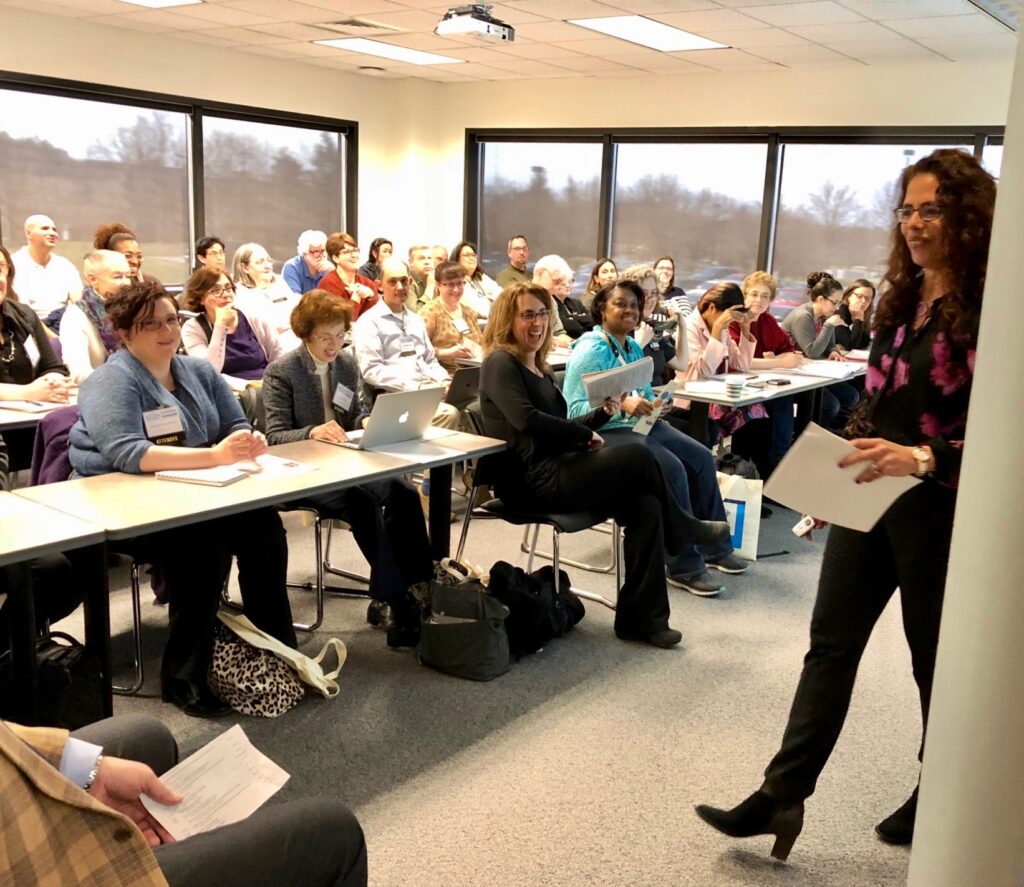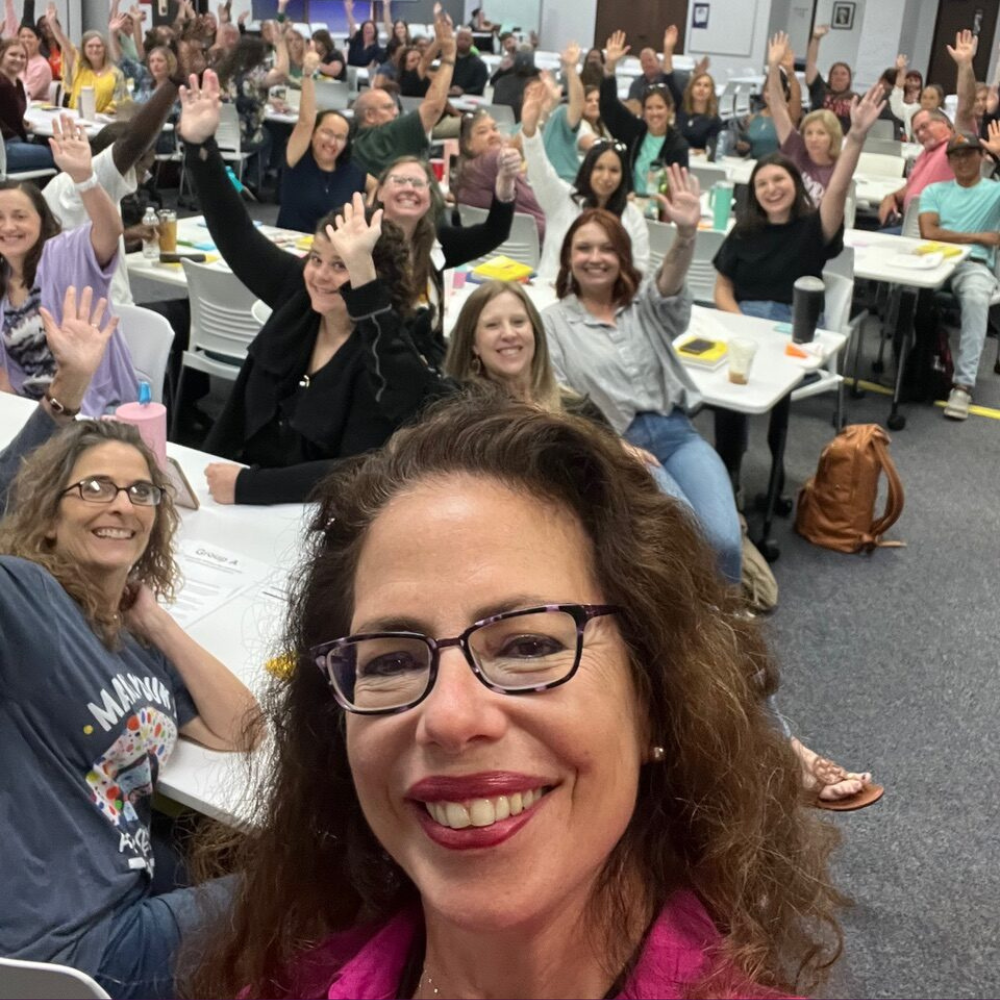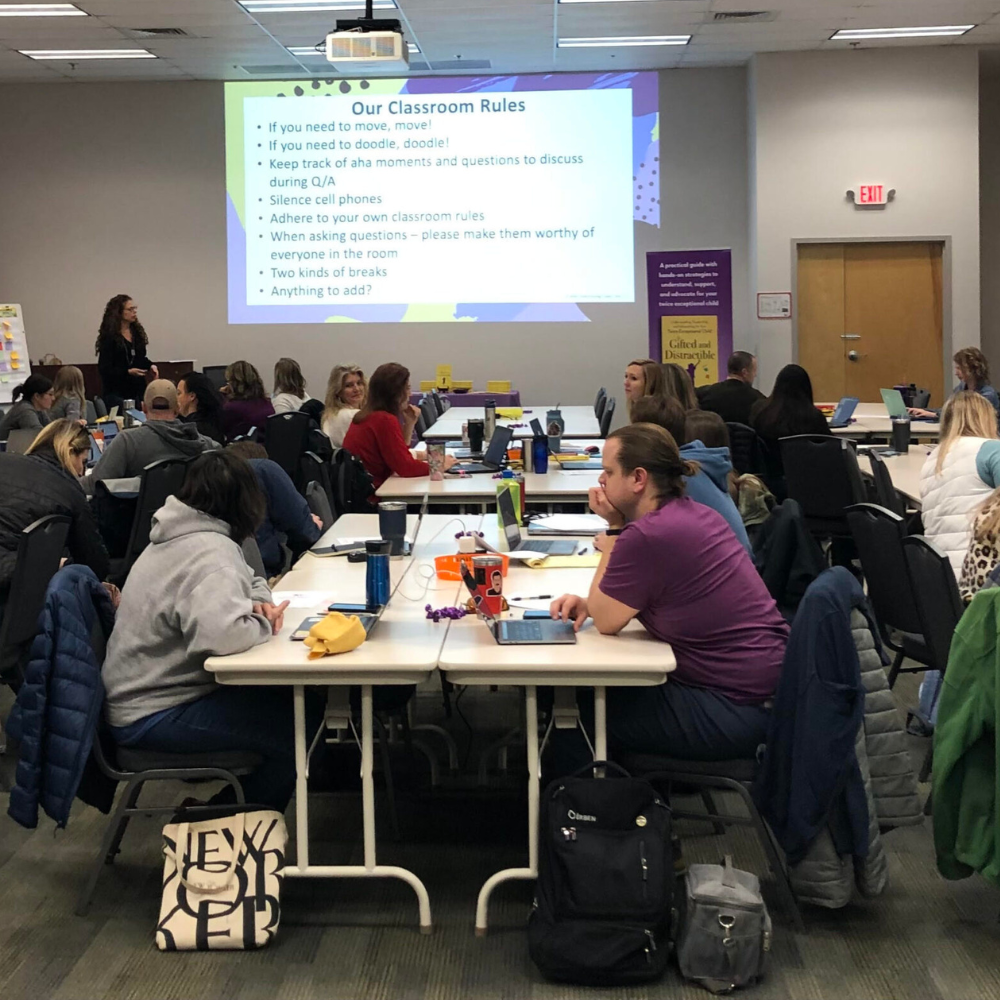Invite Julie to Speak
In-person or virtually, Julie brings energy and enthusiasm to Conference Keynotes, Teacher Trainings, PTA events or any venue where people want to learn about the Twice Exceptional profile and strategies to bring out the best and raise self-confidence in 2e kids. Attendees often comment on Julie’s passion. Julie can also train your child’s teachers. Share this page with your County’s Professional Development Administrator, Special Education/Gifted Education Programmer, or your school’s Administrator.
Keynote: Gifted and Distractible 24/7
Twice-exceptional individuals don’t clock in and out of being 2e—they live it, every hour of every day. In this inspirational and engaging keynote, award-winning author of Gifted and Distractible invites us to step into a strengths-based mindset that transforms how we see and support gifted and distractible learners—and adults.
Click A Topic To Learn More and Book
Gifted and Distractible 24/7
Short Description: This keynote focuses on strengths over deficits and using artifacts, humor, and a crystal ball – to demonstrate how to inject purpose into our interactions with 2e minds.
Long Description: We actually know a lot about our gifted and distractible learners. As parents and educators, we can anticipate when things are likely to go smoothly and when things are, well, likely to be not so smooth. The same thing goes for 2e adults. The thing is, when you’re twice exceptional – you’re not sometimes twice exceptional, you’re twice exceptional twenty-four seven.
The choice we all have as the 2e individual or the person who lives with, loves, teaches, or works with the 2e individual, is to focus on strengths or concentrate on deficits. In this talk, author of the much acclaimed and award-winning book, Gifted and Distractible, helps us determine purpose in our interactions, demystifies “giftedness,” demonstrates different types of brilliance, and leans on 2e adult reflections to illuminate how important it is to focus on strengths as we move through this world as, or with, gifted and distractible humans.
Celebrating the Essence of a Gifted and Distractible Child
Description: The book Gifted and Distractible: Understanding, Supporting, and Advocating for Your Twice Exceptional Child concludes by emphasizing the crucial role of self-love, noting that children who are twice exceptional (2e) often develop a negative self-image. So, how can we help these children cultivate a sense of self-worth?
As the gifted and distractible child navigates life, they often accumulate what can be described as “layers of mud”—experiencing misunderstandings, fluctuating expectations (either too high or too low), a strong desire to succeed, and a longing to build meaningful connections. Despite our best intentions, we may push 2e learners to conform, or meet our goals, without taking into account the 2e child’s needs. Often expectations don’t align with the child’s complex profile. This isn’t about lowering expectations but rather adjusting them to better suit the child’s needs.
In this session, participants will learn the Know-Show-Control method for addressing the unique challenges 2e learners face while fostering their independence and agency. By gaining a deeper understanding of how perspectives—both the adults’ and the 2e child’s—can differ, participants will explore how these mismatched views can lead to frustration, resentment, and negative self-perceptions. Participants will learn strategies for building authentic connections with 2e learners, embrace their uniqueness, and leverage their strengths to address struggles. These strategies create an environment where the gifted and distractible child can begin to feel good about their authentic self.
Outcomes:
- Participants will learn to recognize perspective differences in themselves and a 2e child.
- This session will demonstrate how to shift focus from deficits to strengths.
- Participants will learn Know-Show-Control approach of parenting and teaching.


Breakout Sessions
Breakout sessions are designed to delve deeper into various topics like emotion regulation, ADHD, 2e adults, and parent-teacher collaboration. Each session offers strength-based and practical tools to help your audience set and meet their goals.
Click A Topic To Learn More and Book
Understanding and Addressing Emotional Dysregulation
Short Description: Learn why your twice exceptional learner seems “over sensitive” or reacts in ways that appear out of sync to what bothers him. Discover how to respond rather than react to your 2e learner’s challenging behavior. Learn why emotion regulation seems like a 2e characteristic, the formula for emotion regulation and responses to bring calm to your classroom and home.
Long description: Emotion regulation is often a challenge for twice exceptional children. Grappling with intensities, a strong sense of justice, frequently challenged with output and frustrated by a lack of social nuance, our 2e learners can act out in ways that seem out of sync with what is frustrating them at a particular moment. It is imperative to understand what lies beneath behavior and to consider that seemingly severe responses, may be triggered by environments where they feel repeatedly misunderstood.
In this session gain a deep understanding of the 2e profile and why it lends itself to emotion dysregulation, a ‘Formula for Emotional Dysregulation’ how to understand what underlies your child’s/student’s behavior, and best ways to respond, rather than react, to stop or shorten the downward cycle. Using research and practice, the presenter will also discuss screen time as a potential cause for dysregulation — and will share an approach to help 2e kids understand how screen time may affect their ability to regulate emotions, as well as a suggested structure for addressing screen time. Attendees will learn strategies for reducing anxiety, which is often attendant to emotion dysregulation, and will be able to recognize what helps a 2e child to fill (or empty) his ‘bucket of resilience.
Learning Outcomes:
- Attendees will learn why the 2e profile includes emotion dysregulation.
- Attendees will understand what precedes emotion dysregulation and the attendant challenging behavior.
- Attendees will gain effective and practical interventions to address emotion dysregulation for the home and classroom.
The Uncanny Likeness Between Gifted and ADHD
Short Description: “Easy things are hard and hard things are easy” for gifted children with ADHD. Caregivers and educators will deeply understand the similarities and differences of gifted and ADHD profiles and why one elicits a ‘glass half full,’ and the other a ‘glass half empty’ response. Attendees learn strategies and advocacy tools to bring out the best and raise self-confidence in Gifted/ADHD learners.
Long description: The objective of this presentation is to help parents and educators understand the similarities and differences between giftedness and ADHD and how one condition garners a “glass half-empty” approach and the other, a “glass half-full” approach. Juxtaposing giftedness and ADHD characteristics and myths, participants will learn to shift deficit thinking toward a strength based approach by recognizing specific needs of the twice exceptional learner identified with ADHD. Specific strategies that are particularly impactful include: forging and maintain personal connections, reframing typical gifted/ADHD characteristics and behaviors, anticipating challenging behavior by identifying lagging skills and unsolved problems, giving meaningful choices that allow the child to take control, and utilizing sense of humor and exercise.
The overarching conclusion is that all kids want to do well and that gifted/ADHD kids come with incredible potential (super powers) because, not in spite, of their differences. We must circle the wagons of the adults in twice exceptional kids’ lives in order to support them in a way that strengthens their self-confidence and allows them to thrive. (Sources: A Parent’s Guide to Gifted Children, To Be Gifted and Learning Disabled, The Columbus Group Definition of Gifted, Thinking Smart About Twice Exceptional Learners: Steps for Finding Them and Strategies for Catering to them Appropriately, DSM-V, various sources from Piechowski, Renzulli, Silverman, Baum)
Learning Outcomes:
- Differentiate the diagnoses of gifted and ADHD and why it’s important to consider each learner individually as opposed to the sum of their diagnoses.
- Demonstrate the effects of being twice exceptional through research and anecdotal evidence.
- Learn strength-based interventions to address strengths and struggles of the 2e child identified with ADHD.
The Gifted and Distractible Adult – Finding Professional and Personal Fulfillment
Short Description: For twice exceptional adults, meaningful interactions are imperative. Confusion over one’s complexities – strengths and struggles – impedes the ability to connect and find meaning. We will unmask the realities of 2e adulthood, parse apart myth vs reality, address family relationships, expectations, and how to increase meaning at work and at home, while shedding light on how to create community.
Long Description: The gifted field provides insights and guidance on teaching and parenting gifted and 2e learners. Research and resources for gifted and twice exceptional adults is comparatively small. The presenter has spent well over a decade supporting and guiding international 2e adults to find personal and professional fulfillment. This presentation is informed by client-based research, as well as available resources regarding gifted and 2e adults, theory of mind, positive psychology, communication studies, self determination theory, theory of positive disintegration, anxiety, and learning differences to help 2e adults find personal and professional fulfillment.
We will dive deeply into what it means to be gifted and distractible utilizing the Columbus Group definition as well as the Three-Layer-Cake definition (Skolnick, 2023) of giftedness. Participants will learn to debunk common misconceptions and myths regarding giftedness and twice exceptionality. We will explore strategies to navigate social interactions, manage emotions effectively, and improve communication skills. Participants will discover how to foster healthier and more fulfilling connections with loved ones without masking, and will learn to positively reframe using Dabrowski’s Theory of Positive Disintegration. We’ll discuss effective tools to enhance productivity, and finally we’ll address combatting loneliness and the importance of creating a long-lasting, meaningful community.
Outcomes:
- Participants will gain a research-based understand of the meaning of giftedness and twice exceptionality.
- Participants will learn strategies to address emotional dysregulation to enhance social interactions and foster long-lasting community connections.
- Participants will practice tools to increase productivity and strengthen executive functioning skills.
Top 10 Strategies for Successful Communication Between Parents and Educators
Short Description: Advocacy is often emotional when 2e children are involved. Challenging behavior in gifted and 2e students can lead to parent/teacher and teacher/student conflict. To successfully communicate in a collaborative manner as well as foster open communication to support gifted and 2e learners, the adults at the table must be able to cooperate and manage their own emotional responses. In this session, participants will benefit from unraveling the complicated challenges of the gifted and 2e profile, why communication is often challenging between parents and teachers and how to overcome those obstacles to create a collaborative partnership of understanding and impactful strategies.
Long Description: Challenging behavior in gifted and 2e students can lead to parent/teacher and teacher/student conflict. To successfully communicate in a collaborative manner as well as foster open communication to support gifted and 2e learners, the adults at the table must be able to cooperate and manage their own emotional responses. In this session, participants will benefit from unraveling the complicated challenges of the gifted and 2e profile, why communication is often challenging between parents and teachers and how to overcome those obstacles to create a collaborative partnership of understanding and impactful strategies.
This session will set up the why behind challenging communication including the complexity of the 2e profile, as well as the how to successfully communicate to foster collaboration. The top ten strategies that will be taught and explained include: 1. Build and Foster Relationships, 2. Collaborate, 3. Make Deposits, 4. Give the Benefit of the Doubt, 5. Don’t take it personally, 6. Be a Role Model, 7. Respect, 8. Don’t Take it Personally, 9. Take a Break, and 10. Advocate.
Learning outcomes:
- Attendees will learn why collaboration between educators and parents can be difficult and complex.
- Attendees will gain tools to regulate emotions during advocacy and collaboration between educators and parents.
- Attendees will walk away with 10 immediately applicable strategies for positive and productive collaboration between educators and parents.
Half-Day Educator Training
This dynamic three-hour training brings together educators, administrators, specialists, and service providers to gain an in-depth understanding of gifted and distractible learners. Through case studies, participants will explore best practices for supporting these students in the classroom.
The session concludes with a hands-on group project, where educators collaborate to tackle challenges, leaving them feeling empowered and equipped with the tools to boost the confidence and self-love of twice-exceptional learners.
Click A Topic To Learn More and Book
Half-Day Teacher Training
The training will include several breaks and small and large group shares and can include 2 of the following topics per 3.5 hour training
- What does it mean to be Gifted and Distractible?
- What are best practice strategies for Gifted and Distractible learners?
- Why is emotion regulation a challenge and how to address those challenges?
- Educate teachers about the unique profile of twice exceptionality. What are the typical behavioral challenges, how do those challenges play out in the classroom and what are best practices to address those challenges?
- Bring teachers together to share their experiences of what goes right and what goes wrong for “challenging children” in their classrooms.
- Share best practices from the field while teachers discuss their personal experiences – successes and struggles – to yield a culture of communication that allows for deeper understanding and meaningful support moving forward across classrooms and campuses.
Participants receive resources and hand-outs.
Potential Add-On Topics:
- How to collaboratively advocate between educators and parents.
- Executive Functions: Why Gifted and 2e Learners Struggle, and How Strength-Based Instruction Can Help
1 Hour Training
asdf
Teacher Team Meetings
asdf

Book Study
In this book study, participants explore Julie’s book, Gifted & Distractible, and dive into Skolnick’s three-part Cycle for Success: Understanding, Strategies, and Advocacy for twice-exceptional learners. Julie will join participants for one or three sessions to answer questions and provide additional insights.
What Others Are Saying




